Key takeaways:
- Approximately one-third of global food production is wasted, contributing to significant environmental issues and resource loss.
- Effective meal planning and proper food storage can greatly reduce food waste and foster creativity in cooking.
- Utilizing leftovers creatively and embracing “ugly” produce can transform potential waste into delicious meals.
- Composting food scraps not only reduces landfill waste but also enriches garden soil, promoting sustainable practices.
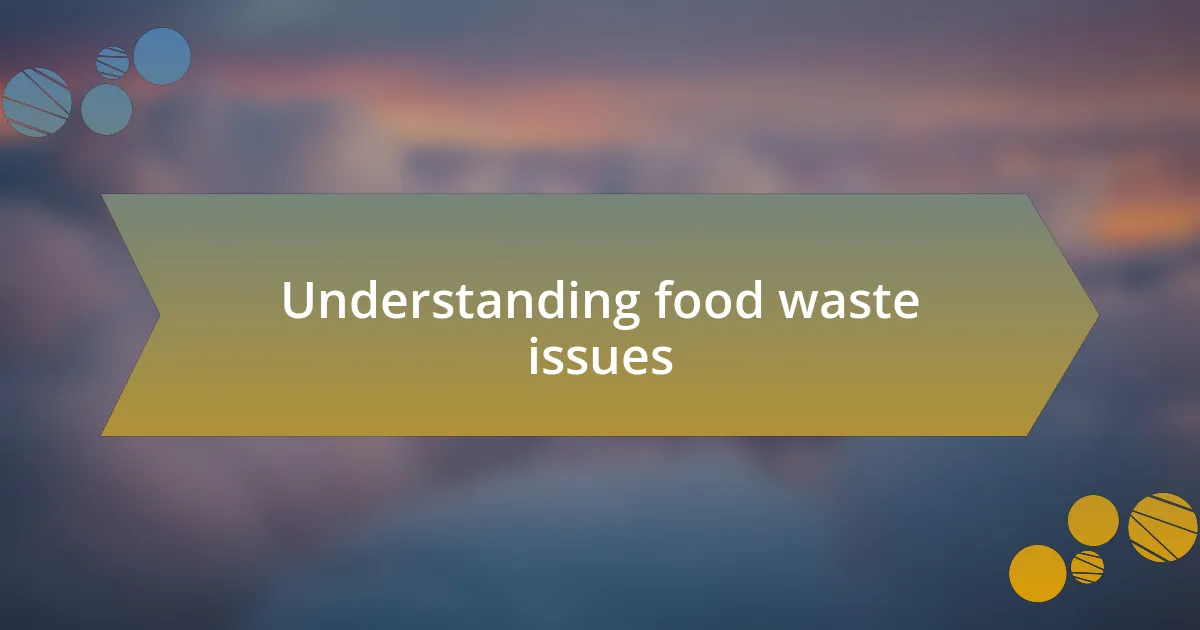
Understanding food waste issues
Food waste is a pervasive issue that often goes unnoticed in our daily lives. I remember a time when I would buy ingredients without thinking twice, only to find them discarded weeks later, which filled me with regret. It made me wonder: how many meals could I have created instead of tossing those perfectly good ingredients in the trash?
The statistics are startling—roughly one-third of the food produced globally is wasted. This statistic resonates with me deeply, especially considering the emotional weight attached to food. Each item has a story, a purpose, and when wasted, it represents not just lost nourishment but also the resources, labor, and time invested in its creation. Wouldn’t it be more fulfilling to honor that journey instead?
Understanding the dynamics behind food waste is crucial. I’ve often asked myself why we overlook the value of food, and it’s clear that societal habits play a huge role. From overbuying due to flashy promotions to mistaking “sell by” dates as “throw away” markers, I realized that awareness is the first step toward minimizing waste. How many of us have fallen into these traps?
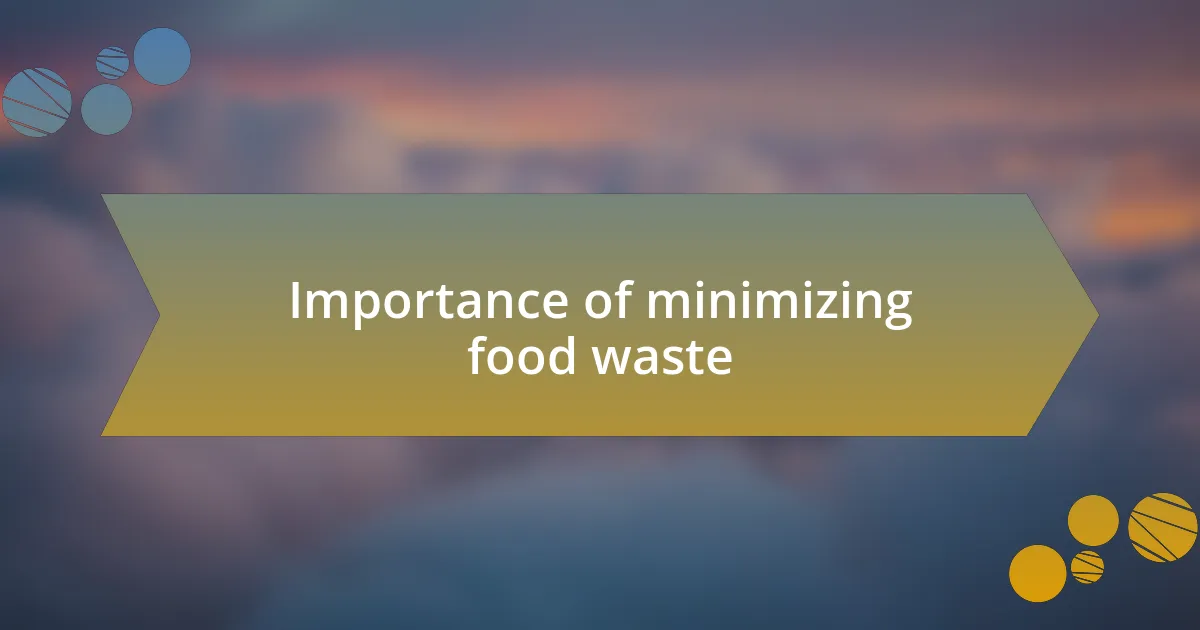
Importance of minimizing food waste
Minimizing food waste is not just an ethical responsibility; it’s also an emotional journey that can significantly impact our environment and communities. I recall hosting a dinner party where I meticulously planned the menu, only to end up with leftovers that sat in my fridge, slowly losing their charm. That experience made me realize how much effort goes into food preparation—and how disheartening it is to see that effort go to waste. Why not turn those leftovers into creative new meals instead?
On a larger scale, the implications of food waste are staggering. I learned that wasted food contributes to about 8-10% of global greenhouse gas emissions, which is a serious concern for our planet. This statistic struck me hard. It presented a clear message: by being mindful of our food habits, we can directly influence the health of our environment. Why wouldn’t I want to be part of that solution?
Moreover, minimizing food waste fosters gratitude and connection. I’ve found joy in transforming what I once considered scraps into delicious meals. Incorporating vegetable peels into stocks or turning stale bread into croutons has not only minimized waste but also added a new level of creativity to my cooking. Isn’t it rewarding to know that we can create something wonderful from what we might have previously overlooked?
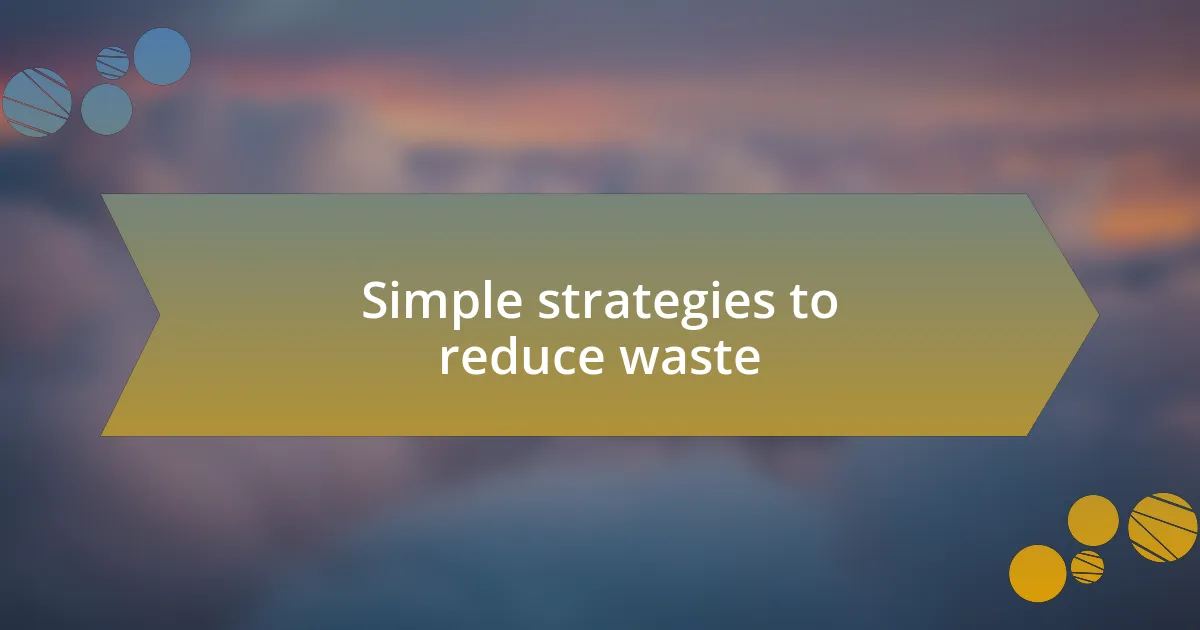
Simple strategies to reduce waste
When it comes to reducing food waste, planning meals ahead of time has proven invaluable for me. I used to wander into the grocery store with no clear idea of what I needed, often ending up with random ingredients that would eventually spoil. Now, I take time each week to create a meal plan based on what I already have, helping me buy only what I need. Have you ever noticed how empowering it feels to shop with intention?
Storing food properly has also transformed my approach to waste reduction. I remember the days when I would toss wilting herbs or fruit that had gone soft without a second thought. After learning about proper storage techniques, I now keep herbs in water like flowers and place fruits in the right spots in the fridge. This simple change has extended the lifespan of my produce significantly. Isn’t it amazing how a little knowledge can have such a big impact?
Another strategy that’s worked wonders for me is involving my family in the waste reduction journey. I’ve started hosting “clean-out-the-fridge” nights where we all pitch in to create a meal from whatever leftovers or near-expiration items we have. Not only does it cut down on waste, but it also turns into a fun, collaborative cooking experience. Have you ever explored the creativity that comes from using up what you have on hand?

Planning meals effectively
Effective meal planning is all about being mindful and intentional, which has significantly influenced my shopping habits. I recall a week when I diligently checked my pantry and fridge before drafting my grocery list. Instead of succumbing to impulse buys, I focused on creating meals around the ingredients I already had. This shift not only reduced waste but also sparked my creativity in the kitchen. Have you ever felt that rush of satisfaction when turning leftovers into a delightful new dish?
I’ve also learned to think ahead when it comes to unplanned events. For instance, I keep a few versatile recipes on hand for those days when life gets hectic. One day, when unexpected guests arrived, I was able to whip up a quick stir-fry with just a few staple ingredients and some leftover vegetables. The joy of sharing a delicious and waste-free meal felt incredible. How often do we underestimate the power of having a backup plan in our cooking routine?
Another insight I’ve gained is the importance of flexibility in my meal plans. While I do like to establish a framework for the week, I give myself the freedom to adjust based on what’s available or on sale. There have been moments when I found a beautiful bunch of asparagus at the market, prompting an impromptu addition to my meal plan. Embracing this flexibility has made cooking feel less like a chore and more like a delightful adventure. Have you ever tried mixing spontaneity into your meals?
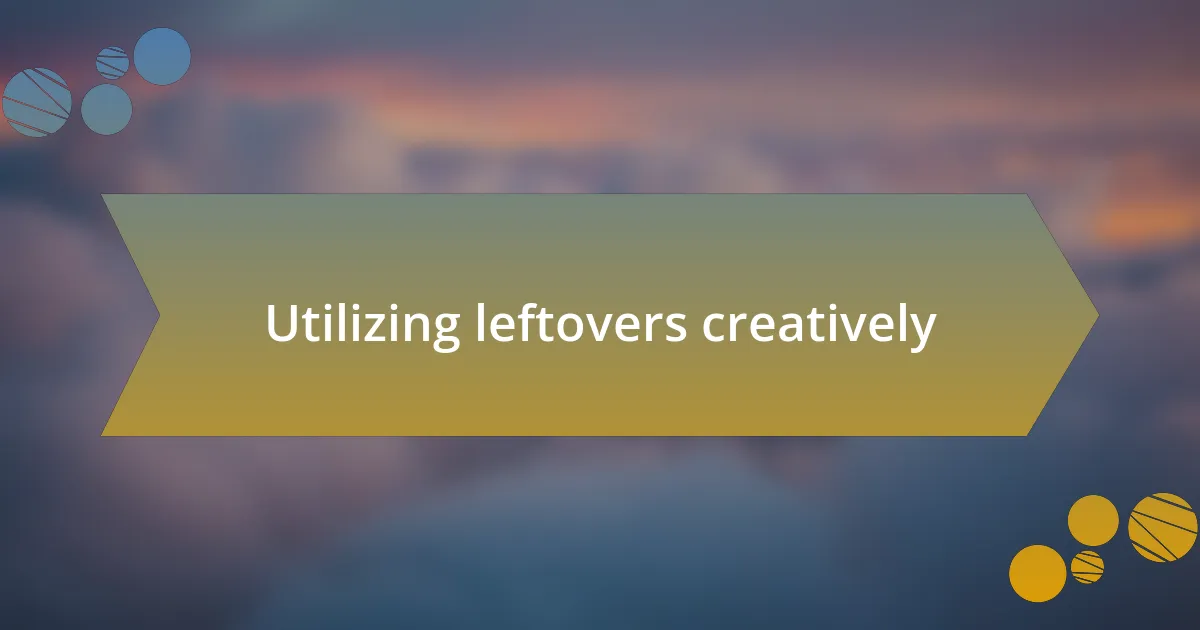
Utilizing leftovers creatively
When it comes to utilizing leftovers creatively, I find that inspiration often strikes when I least expect it. Just the other night, I had some roasted chicken and vegetables lingering in the fridge. Instead of letting them go to waste, I decided to transform them into a hearty soup. The warmth of the broth and the fact that I turned what could have been trash into a comforting meal truly made my evening feel special. Have you ever felt that sense of triumph when improvising in the kitchen?
Sometimes, the key to creativity lies in the simplest of combinations. I often take leftover grains, like quinoa or rice, and mix them with whatever is on hand—be it a dash of soy sauce, some sautéed greens, or even canned beans. It feels like a little culinary puzzle where each leftover becomes a piece that fits perfectly into a delicious picture. What’s your favorite way to mix and match leftovers for a new dish?
Additionally, I’ve discovered that wrapping leftovers in a tortilla or serving them over a bed of fresh greens can instantly elevate a meal. Last week, I turned some nearly-forgotten mashed potatoes into delightful potato pancakes. The crispy edges and soft, flavorful centers made it hard to believe these were leftovers. It’s in these small acts of creativity that I find joy in minimizing food waste and building a deeper connection with my meals. How do you take simple leftovers and make them feel new again?
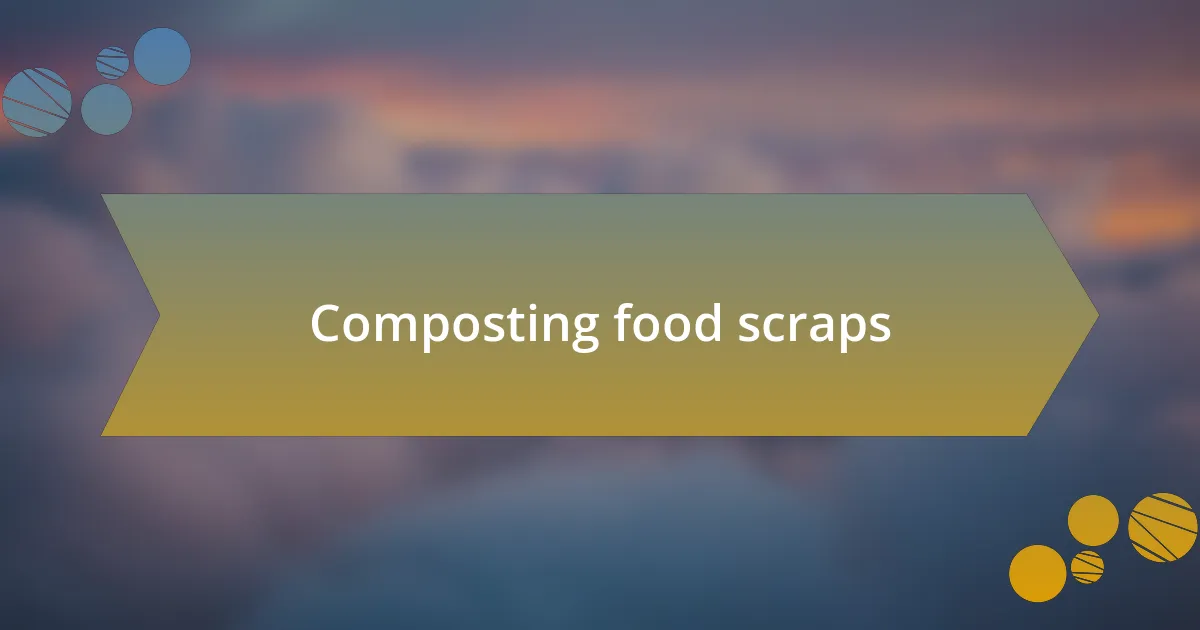
Composting food scraps
One of the most rewarding aspects of minimizing food waste has been my journey into composting food scraps. Initially, I was apprehensive about getting started—would it be complicated or smelly? However, once I set up my small compost bin, I was amazed at how easy it was to toss in vegetable peels, coffee grounds, and even the occasional eggshell. Watching those scraps transform into nutrient-rich compost gives me a sense of accomplishment that I never expected. Have you ever contemplated the life cycle of your food waste?
As I’ve delved deeper into composting, I’ve discovered that it not only reduces landfill waste but also enriches my garden soil. I remember harvesting my first batch of compost and spreading it around my plants—seeing the difference in their growth was incredibly satisfying. Knowing that I played a part in creating healthy soil while keeping organic waste out of the trash fills me with pride. What would it feel like to watch your scraps make a difference in your own garden?
Setting up a compost bin has also sparked discussions with friends and family about sustainable practices, providing an opportunity to share my experiences. I often encourage others to try it out, sharing tips like layering green and brown materials for optimal decomposition. I genuinely believe that composting is a simple yet impactful way to contribute to the environment. Have you thought about how even the smallest efforts, like composting, can lead to significant changes in our world?

My personal journey and tips
Making the switch to meal planning was one of my best decisions for minimizing food waste. In the beginning, I often found myself overwhelmed by how much food I would toss out simply because I lost track of what I had. By dedicating just a little time each week to jot down meals and what ingredients I needed, I’ve cut down excess purchases significantly. Have you ever noticed how a little planning can change your entire shopping routine?
Another tip that has worked wonders for me is being mindful of portion sizes. I used to serve generous helpings, leading to many leftover days that ultimately ended up in the trash. Now, I serve smaller portions and save any extras immediately for lunch or dinner the next day. The excitement of transforming a leftover into a brand-new meal has turned what once felt like a chore into a delightful culinary adventure. How often do you let creativity with leftovers inspire you?
One final practice I’ve adopted is to embrace “ugly” produce. Initially, I hesitated to buy misshapen fruits and vegetables, thinking they might not taste as good. However, I discovered that these items were often overlooked and significantly discounted. I vividly remember cooking up a beautiful soup with a distressed-looking carrot and some strange potatoes, and it ended up being one of the most delicious and heartwarming meals I’ve made. Don’t you think that sometimes, the best things come wrapped in unexpected packages?